In May 1883, the captain aboard the German ship Elizabeth observed ash spewing above Krakatoa, an island in the Sunda Strait between Java and Sumatra in Indonesia. In the following weeks, other vessels reported hearing thunder and seeing incandescent clouds. Locals would also report earthquakes as small volcanic eruptions rumbled across the island.
Little did they know that these were the early signs of what would become one of the biggest volcanic eruptions in recorded history. Krakatoa erupted on Sunday August 26th 1883, sending volcanic dust as high as 24km (15miles) into the atmosphere.
The following day on August 27th, two enormous explosions were heard as far away as Australia, with the final eruption destroying two-thirds of the island and triggering a powerful tsunami that wiped away entire settlements and was felt all the way across the Indian Ocean in South Africa. It’s estimated that 36,000 people died in this natural disaster.
The eruption also had a marked impact on the global climate, sending a very large amount of sulfur dioxide (SO2) into the stratosphere, which led to a global increase in sulfuric acid concentration. This in turn increased cloud coverage that dimmed sunlight, sending global temperatures down by at least 0.4°C the following year. As submarine telegraph cables were already in use, news about the eruption was relayed rapidly across the globe, hitting the newspapers in New York, London and Paris by August 28th.
Major climatic events typically leave chemical signatures or signals that are stored in ice core rings. More specifically, volcanic eruptions are associated with spikes in sulfate aerosols. By looking at ice core data from during the time of the eruption, we can check for such signatures left by the volcano. Krakatoa lies near the equator, so we should expect strong signals in both the Greenland and Antarctic records. In 2015, a study led by Michael Sigl tied – to a fine degree – ion compositions of ice core rings from both poles with notable historic volcanic eruptions:
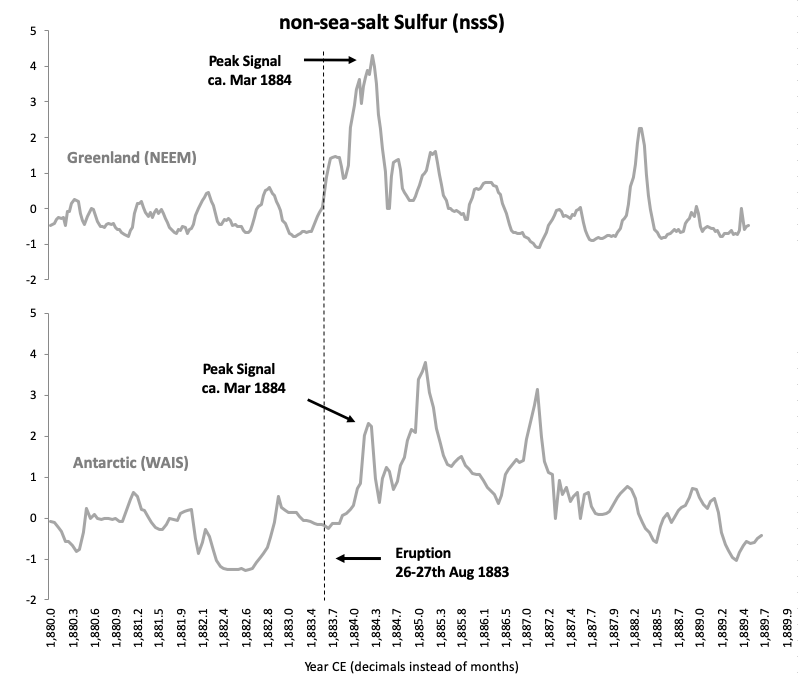
The sulfur concentrations in their chart are corrected to exclude sea-salt sulfur contribution. A spike in sulfur is clearly visible in the months following August 1883. When faced with an anomalous signal in ice core data, in order to confidently associate a signal with an historically recorded climatic phenomenon such as a volcanic eruption, it’s important to take into account the time it takes for aerosols to build up after the event. Gao et al delineate a model for sulfate aerosol that is corroborated by evidence of recent eruptions:
“To generate the time-dependent data, we assume a linear buildup of the total aerosol mass for 4 months after eruption, leading to a maximum mass loading according to the strength of the eruption. After that we assume an exponential decrease of the stratospheric aerosol mass with a global mean e-folding time of 12 months. Since the major sink mechanism for stratospheric aerosol is stratosphere-troposphere folding in midlatitudes and the Brewer-Dobson circulation related sink in high latitudes [Holton et al., 1995], we assume little loss due to sedimentation in the tropical regions (e-folding time of 36 months) and keep the sedimentation to an average e-folding time of 12 months in the extratropics. In the polar region, we set the e-folding time to be 3 months during winter to account for the strong subsidence in the polar vortex and 6 months for the rest of the year. Figure 5 shows an example of the resulting spatial and temporal distribution of the aerosol optical depth during the first 3 years after the Pinatubo eruption in 1991, where we see a linear increase of aerosol loading for the first four months and the seasonal transport to the poles.“
Given the above information, the 27th August date of the Krakatoa eruption matches well with the spike in the NEEM (Greenland) and WAIS Divide (West Antarctic Ice Sheet) records, starting at the time of the eruption and peaking in early 1884.
The Krakatoa eruption is one of the most studied climatic events in recent history. However, few recall that a major event of a cosmic nature occurred just the previous year, one that may have indirectly ‘triggered’ the eruption.
The Great Comet of 1882
The year prior to the Krakatoa eruption was marked by the sighting of a bright object in the skies that became known as the Great Comet of 1882. It might in fact be the brightest ever observed in recorded history. The comet was first seen in early September at the Cape of Good Hope and became visible across the Southern Hemisphere shortly thereafter. Within days, a ‘blazing star’ flying near the Sun would be seen by observers across the globe, becoming visible in broad daylight.
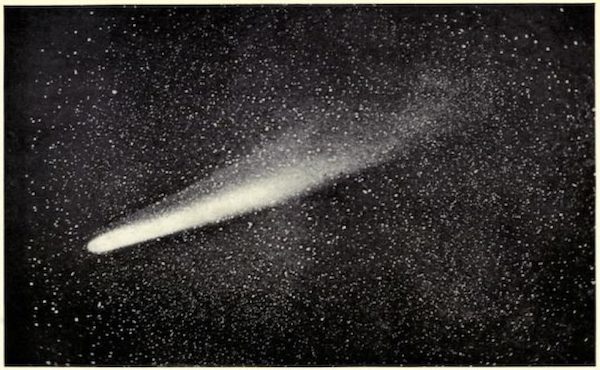
On September 30th observers noticed that the nucleus had broken into two parts and by mid-October the comet had visibly broken into five fragments. The comet reached peak brightness in December of the same year, remaining visible to the naked eye until February 1883.
Comet fragmentation is a very common occurrence. As described by Pierre Lescaudron in Earth Changes and the Human-Cosmic Connection (adapted from chapter 15):
“Fragmentation is the logical way for individual comets to cope with high electric stress, causing any given comet to go through a process of fission (i.e. splitting into two or more parts).
“When a sphere is divided into two equally-sized spheres, the total mass will remain the same (no matter disappears) but the total surface area of this pair will be about 26% larger than the area of the original single sphere.
“This increases the total surface area exposed to the electric field and thus decreases the current density (amperes per square meter).
“Thus, electrically-induced fission enables comets to reduce the electric stress they are subjected to by spreading it between two or more bodies (hence the reported decrease in brightness).“
Just recently, Comet ATLAS elongated its nucleus and fragmented.
Astronomers have been tracking comets for a long time, measuring their orbits to see if they pose any threat to our planet. However, in most cases these objects are so small compared to the vastness of the space they move through that they are extremely hard to track. Even recorded comets become difficult to track once they fragment or loose their brightness. As a result, “in the early 21st century impact prediction usually doesn’t work. Almost all of the asteroids that hit Earth are a surprise.“
The Great Comet of 1882 has since been identified as a member of the Kreutz sungrazers, a ‘family’ of comets that passes extremely close to the Sun at perihelion, often fragmenting. These comets are thought to have originated from a giant comet that entered the solar system and broke up into many smaller comets centuries ago.
According to historical records, there is no account of any large celestial body having impacted or otherwise crossed paths with Earth. But the latest advancements in science – specifically in paleo-climatology, which uses stratigraphic markers from ice core rings, marine sediments and tree ring data – are now telling us a ‘new history’.
There are two specific cosmic events we can refer to, one that marked Earth’s history during the Upper Palaeolithic, and another much more recent event that took place just over a century ago above a remote forest in Siberia.
Younger Dryas & Tunguska
The Younger Dryas, a catastrophic event that temporarily reversed Earth’s climate, took place around 12,900 years ago, circa 10,900 BC. The Younger Dryas period saw the climate return to glacial conditions similar to what was experienced during the preceding Late Glacial Interstadial, in the middle of a climatic warming period.
According to the theory, a large comet entered the atmosphere and broke apart above North America, slamming into the Laurentide Ice Sheet and producing multiple airbursts along with surface impacts in other locations as the fragments spread throughout the continent, creating huge explosions and destruction across the Northern Hemisphere.
A group of scientists including Richard Firestone and Allen West, authors of The Cycle of Cosmic Catastrophes: How a Stone-Age Comet Changed the Course of World Culture, extracted and analysed soil samples in North America and Europe, where they found high concentrations of iridium, nano-diamonds and a carbon-rich black layer dating back to circa 12,900 years ago, thus coinciding with the abrupt onset of the Younger Dryas cooling. In a subsequent study, researchers also identified atmospheric input of platinum-rich dust in ice core samples from the Greenland Ice Sheet Project 2 (GISP2).
The injection of dust, soot and other toxic chemicals into the atmosphere, as well as water vapour to form continuous cloud coverage, would have led to a substantial reduction in sunlight across the Northern Hemisphere and much of the planet, bringing about the abrupt onset of cooling seen in ice core records.
Temperature can in fact be inferred from ice cores using the water isotopic composition δ18O as a proxy (a measure of the ratio of stable isotopes oxygen-18 (18O) and oxygen-16 (16O)). As shown in ice cores from Greenland, the temperature dropped by 4-10°C.
A new tropical Atlantic subsurface temperature reconstruction indicates it was 7°C warmer than today during the Younger Dryas/Bølling-Allerød (~15,000-11,500 years ago), when CO2 concentrations hovered around 210-220 ppm.
— Kenneth Richard (@Kenneth72712993) May 7, 2019
Reißig et al., 2019https://t.co/GCIVTFJTUb pic.twitter.com/kI7QUEoqUZ
This catastrophic event may also explain the sudden climate change and disappearance of plants and large mammals, including mastodons and mammoths, as well as the disappearance of ‘Clovis settlements’ – humans known to have populated North America at this time – whose sites are overlaid with the carbon-rich black layer that coincides with the Younger Dryas event.
In addition to the observed temperature drops, ice core records reveal large signals of other elements, including a spike in both nitrate (NO3) and ammonium (NH4) levels.
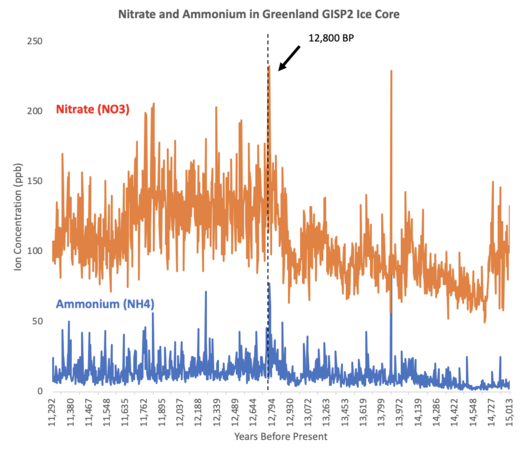
Another more recent event showed a similar and, fortunately, much smaller signal in the ice cores. On June 30th 1908, a bolide entered the Earth’s atmosphere and exploded over the Tunguska river basin in central Siberia with an estimated force of around 10 megaton nuclear explosions. This comet fragment is thought to have been about 40 metres in diameter, and it flattened around 80 million trees across 2,000 km2 of forest.
Several suggestions have been made as to the origin of the Tunguska bolide, but astronomers are beginning to accept that it was part of the Beta Taurid meteor stream. Slovak astronomer Lubor Kresak was first to suggest that the comet was a fragment of Comet Encke, a periodic comet within the orbit of Jupiter which produces a bi-annual meteor shower, one being the Beta Taurids near the end of June, the other being the South Taurids meteor shower during early November.
Tree ring records from Europe show a short but visible reversal in trend, with annual tree ring widths reducing after 1908. Looking at the Greenland ice cores records, a corresponding spike in both nitrate and ammonium as well as sulfate is visible right around this time.
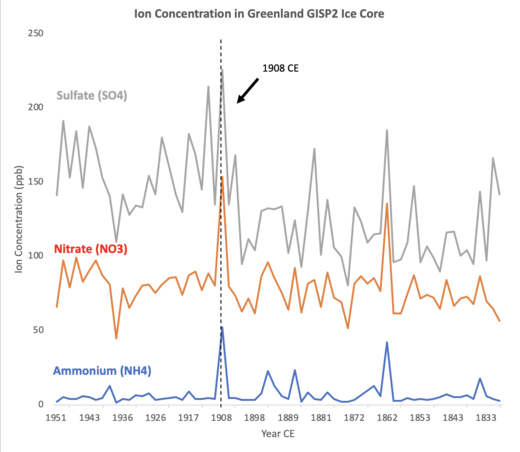
The Tunguska signature reveals a spike in sulfate levels – which, as we saw, is also present in the Younger Dryas layer – although these are typically associated with volcanic eruptions that inject large quantities of sulfur into the lower stratosphere, which then reacts to produce sulfate aerosol particles.
Emissions of both nitrate and ammonium are generally considered indicators of biomass burning of forest fires and grassland. These signals are usually accompanied by high levels of formate (HCOO) and organic markers including vanillic acid and p-hydroxybenzoic acid. However, other factors can also account for higher levels of these ions.
With the advancement of technology, spectral analysis of comets has been conducted to analyse the composition of cometary bodies and their tails. Among the elements identified, ammonia was found to be present in both Comet Hale-Bopp and Comet Alley, with an implied ammonia-to-water ratio in the range of 0.4-2%.
However, it is usually insufficient to account for the high levels of ammonia seen in ice cores matching cometary impact events. In analysing data from the GISP2 ice core, Melott et al describe four ways that a comet can produce nitrate and ammonia when entering the atmosphere – and which would account for the spike observed at the time of the Tunguska explosion.
- Biomass Burning (resulting from the fires generated by the impact)
- Direct Deposit (from the bolide)
- Atmospheric Ionisation (as the comet enters the atmosphere)
- Ice, Atmospheric Ionization and Haber Process
Touching on the first point, Melott explains that biomass burning from the forest fires caused by the explosion cannot account for the high levels of nitrate and ammonium recorded:
“A significant problem exists in using biomass burning to explain the Tunguska event. The synchronous increase in both ions in the ice core data for the winter of 1908-09 in the GISP2 signal is clear and reliably dated with high time resolution. As we shall see, biomass burning can only be a minor contributor to the signal for this event. The area of forest fire burning was only 10-20 km in diameter (Wasson 2003). If we generously assume 100,000 ha of forest burning, the surface density deposition of ammonium over the Northern Hemisphere is only 10^7 kg m-2, only somewhat larger for nitrate. Summing up the nitrate from either GISP2H or GISP2 produces ~5 × 10^6 kg m-2 for the nitrate or ammonium deposition in the wake of Tunguska, so clearly the biomass burning is insufficient. The strong signal in the wake of Tunguska is one of the highest peaks over a recent century (Dreschhoff 2002; Olivier et al. 2006).“
Atmospheric ionisation, Melott’s third mechanism for producing nitrate, suggests that when a comet enters the atmosphere, it ionises the surrounding air, enabling the synthesis of nitrogen oxide. This could explain the observed spikes in nitrate, however ammonium isn’t known to be produced by atmospheric ionisation and, as mentioned above, the amount of NH4 in comets is often too small to account for the high levels recorded in ice cores. The last mechanism Melott outlined is thus the most likely candidate to account for the large presence of ammonia in 1908. Melott explains:
“The Haber process for ammonia synthesis was developed for fertilizer and munitions in 1909. Under conditions of high pressure, nitrogen and hydrogen react to form ammonia. Formation of ammonia is increasingly disfavored thermodynamically at higher temperatures with respect to molecular nitrogen and hydrogen because of the unfavorable entropy of reaction. However, the unfavorable free energy of reaction can be overcome by the high pressure present in the shock front of a comet entering the atmosphere. As the nitrates estimated for both the Tunguska and Younger Dryas from conventional atmospheric process are adequate to explain the data for both events, it is reasonable that the comparable amount of ammonium found in the cores could also be synthesized this way, using cometary ice.“
The assumed ice mass in the Tunguska comet is insufficient to synthesize sufficient ammonia to account for Greenland ice cores. However, it was proposed that at least one fragment may have impacted a swampy, partially melted permafrost area, creating Lake Cheko (Gasperini et al., 2008). Based on the size of the probable crater lake, sufficient water would have been present as a reactant to synthesize the ammonia.
There is debate over whether Lake Cheko was created by the impact or was already present. The presence of the lake prior to 1908, and hence of the water needed to synthesise ammonium, would lend further support to the explanation given by Melott for the signal found in the ice cores.
Examining a Possible Cometary Impact in early 1883
Now let’s go back and look at the ice core signals around the time of the Krakatoa eruption in August 1883.
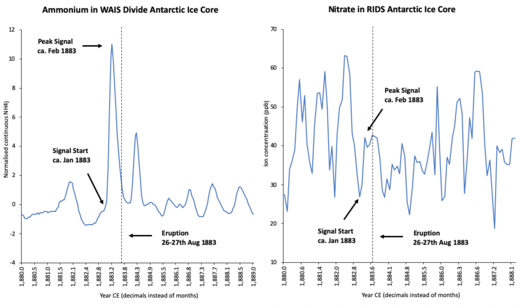
The sulfur spike seen in the records from the non-sea-salt Sulfur (nssS) chart can be confidently associated with the eruption. However, the above chart reveals two large signals for ammonium and nitrate peaking in early 1883. These peaks cannot then be explained by the eruption, which occurred after the spikes chronologically (see vertical dashed line). The ammonium signal you see there is actually the second-largest of the 19th century (for the WAIS Divide ice core anyway), beginning around January 1883 to peak in February of the same year.
Although communication channels were rudimentary at the time, there are no contemporary media reports about a major fire or burning event having taken place in the Southern Hemisphere in the year leading up to the signal. I therefore wonder if these spikes in ammonia and nitrate indicate a cometary origin to the early 1883 signal, possibly by the same mechanism described by Melott for the Tunguska impact, and caused by a comet fragment – a roughly Tunguska-sized bolide – hitting the ocean or an ice sheet (or causing ablation of such via an overhead airburst).
The ice cores also reveal a large spike in bromide:
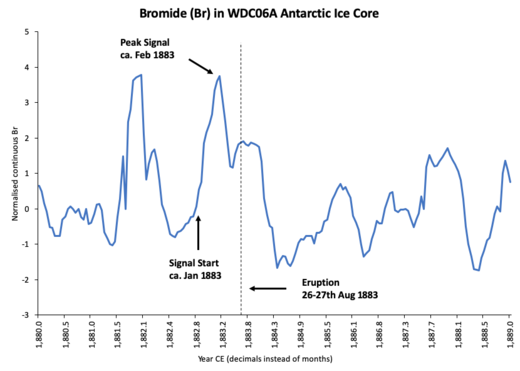
The spike in bromide happens to be one of the strongest signals of the 19th century for the WAIS Divide ice core. Bromide is found in relatively low concentrations in the Earth’s crust, about the same concentration found in meteorites, or 1ppm. So how can we explain the large spike found in 1883?
The ocean contains much larger concentrations of bromide relative to the Earth’s crust. The impact of a comet in the ocean could explain the unusually high signal in the ice core, as explained here by Pierazzo et al:
“The impact of a 500m asteroid increases the upper atmospheric water vapor content by more than 1.5 times the background over a wide region surrounding the impact point for the first month after the impact. Halogens, ClY (chlorine) and BrY (bromide), follow the water vapor distribution, with an initial increase of over 20 and 5 times normal background, respectively, in the same region surrounding the impact. The perturbations eventually spread over the northern hemisphere, where water vapor content remains about 50% above background for the first year after impact, while ClY and BrY exceed five times and twice their background values.“
The strong bromide signal, together with the spike in ammonium and nitrate, supports the possibility that a bolide impacted the Earth somewhere in the southern oceans in early 1883.
Yet another stratigraphic find points to what kind of bolide it might have been. A large black carbon signal was measured in the Summit2010 Ice Core (located near the GISP2 site) for the Tunguska impact event, alongside a spike in titanium.
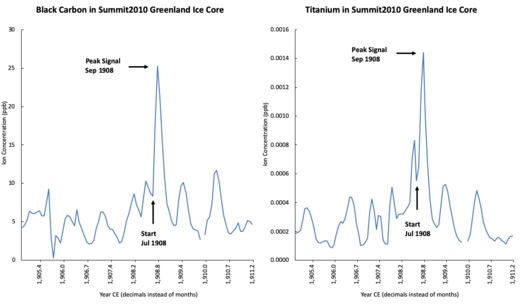
Black carbon is made up of carbonaceous spherules that are formed by the incomplete combustion of biomass and fossil fuel. It absorbs solar energy and, unlike CO2, remains in the atmosphere only for days or weeks before falling down as precipitation. Due to its ability to reduce the reflectivity of a surface (albedo), it warms the snow on which it falls thereby increasing melting. Although black carbon is generally associated with biomass burning, it is not a well-defined compound, comprising different physical and chemical properties from location to location. Can the presence of black carbon in the ice core be explained by another factor?
Besides coming in different shapes and sizes, meteorites have different compositions. There is a class of meteorites called carbonaceous chondrites, or C-type chondrites, that are rich in carbon compounds, water and lithophile elements like silica, including oxygen, titanium and aluminium. This class of meteorites contrasts with others that predominantly contain minerals such as magnesium. The ice core records show no strong magnesium signal in either the Antarctic WAIS Divide for 1883 nor in Greenland for the Tunguska impact. But the latter instead has a strong signal for lithophile elements such as carbon and titanium, further strengthening the hypothesis that the bolide which entered the atmosphere above Siberia in 1908 was a carbon-rich chondrite.
The WAIS Divide core also happens to show the strongest spike in black carbon in the whole 19th century, starting around January 1883 to peak in February of the same year, matching the signal observed in the other elements.
As mentioned earlier, there is no record of a major forest fire or biomass burning event to account for this large spike in the Southern Hemisphere. But is there any evidence of a bolide impacting the ocean?
Should such an event have occurred, we could expect a series of waves extending from the impact point for many miles in all directions. A look at the records from the Australian Bureau of Meteorology shows a series of successive waves hitting the coast of Stanley in Tasmania on December 25th 1882:
“Records of tsunamis affecting Australia since European settlement
“Date: December 25, 1882
Australian region where tsunami effects were recorded: TAS (Tasmania)
Source Region: Unknown
Comments: Four successive waves with the third being three or four feet high reported at Stanley“
While in no way conclusive, given the timing and location of the recorded event, it could point to a cometary impact as the source of the successive waves observed in Tasmania.
Unfortunately, no record of other elements such as titanium are present in the ice core data to strengthen my hypothesis of a bolide impact on or near the southern oceans around the beginning of 1883.
Earth Changes – The Cosmic Connection
Having proposed that a comet fragment entered Earth’s atmosphere in early 1883, perhaps one that broke off from the Great Comet of 1882, I would suggest another ‘impact’ the comet may have had on Earth – albeit one ‘at a distance’: triggering the Krakatoa eruption of May 1883.
Cosmic influence on Earth’s volcanic activity has been widely studied. Researcher Jamal Shrair addresses cosmic ray flux in this article, describing the overwhelming evidence backed by statistical data for a relationship between the solar cycle, earthquakes and volcanic eruptions.
A number of studies have been published in the last decade linking solar activity to ‘Earth changes’. One such study showed an 80%+ correlation of volcanic eruptions of magnitude VEI 5+ with solar activity lows, and an 87.5% correlation for the largest eruptions (> VEI 6), as well as 100% correlation for the 7 most powerful earthquakes.
More recently, a study published by Japanese researcher Toshikazu Tbisuzaki analysed 11 eruptions from silicate-rich volcanoes in Japan in the last 3 centuries and found that 9 of them occurred during a solar minimum. Interestingly, silicate are piezoelectric material – they transduce electric current into mechanical deformation and vice versa.
A third study led by Jann-Yeng Liu in Taiwan found anomalous changes in electron density and electromagnetic signals in the ionosphere occurring in the afternoon/evening 1-5 days prior to large earthquakes of magnitude 6.0 and higher (analysed in Indonesia, China, Japan and Taiwan).
Shrair describes the process that causes earthquakes and eruptions triggered by external pressure induced on the magnetic field of the Earth:
“Fluctuations of cosmic-solar radiations are charging the ionosphere. That results in anomalies of geomagnetic fields which causes the generation of eddy current. The eddy current heats the rocks in the faults and consequently the shear resistant intensity and the static friction limit of the rocks would decrease. This is the main process that triggers earthquakes and volcanic eruption.“
Substantiating the idea that eruptions and earthquakes are being triggered by solar radiation, since the late 18th century all major eruptions (apart from the 1991 Pinatubo eruption) have occurred during periods of low solar activity. These include Grimvotn in 1783-85, Tambora in 1810, Krakatoa in 1883, Santa Maria in 1902 and Novarupta in 1912. More recently, 11 major earthquakes of magnitude 8.0 and higher were recorded after solar activity declined between 2004 and 2010.
So what about comets; do they also play a role in Earthly events?
In Earth Changes and the Human Cosmic Connection, Pierre Lescaudron describes the electrical nature of the cosmos and explains a possible mechanism whereby comets induce volcanic eruptions:
“The Sun is electrically active and positively charged. It is surrounded by an electrically negative layer (heliosphere) that extends beyond the solar system.
“The sun-heliosphere couple acts like a giant capacitor that is discharged by planetary alignments and/or foreign objects entering the solar system, in a way similar to a bug zapper discharging when a mosquito flies inside it.
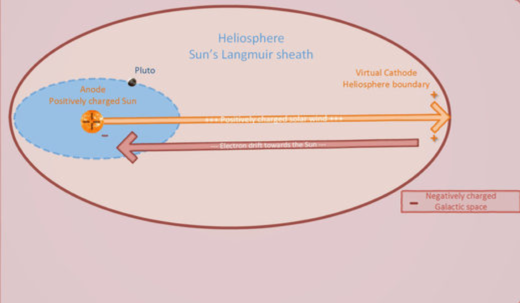
“A prime candidate for triggering such solar discharges are comets because they are electrically very active (as indicated by their intense glow) and have conductive plasma tails that extend hundreds of millions of kilometers.
“When a comet triggers a discharge of the solar ‘capacitor’, the Sun releases Coronal Mass Ejecta (CME), which are massive quantities of protons (positively charged particles). These discharges, if properly oriented, can reach Earth.
“When solar activity is weak, Earth receives little (positively charged) solar winds (small yellow arrow). As a consequence, the electric potential of Earth’s ionosphere is less positive and it tends to attract fewer free electrons from the Earth to its surface, making it less negatively charged. As a result, the electrical field between the ionosphere and the Earth’s surface (atmospheric E-field) is reduced.
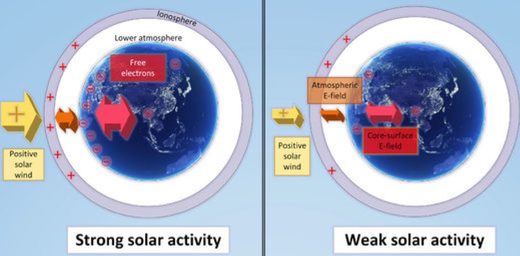
“With fewer free electrons attracted from the inside of the Earth to its surface, the electric field between the Earth’s surface and its core is also lowered.
“This electric field is the binding force of the planet; it ‘holds the planet together’. A brutal solar discharge can induce a sudden spike in the positive charge of the ionosphere, which translates into a sudden surge in the binding force. A crude but accurate enough analogy is if you were to hold an orange in your hand and then suddenly squeeze it.
“This ‘planet squeeze’ is not the only effect of cometary-triggered solar discharges. The Earth’s spin is powered by the Sun too. When the Earth is hit by a solar discharge, it goes through a minute acceleration. Such acceleration can have two consequences:
- Minute crustal slippage. The density of the crust is lower than the density of the mantle, therefore the crust and the mantle won’t slow down at the same rate. The mantle being denser, it has a higher momentum and won’t slow down as fast as the crust. The difference in rotation between the crust and the mantle is equal to the crustal slippage. Crustal slippage, and the tremendous stress it exerts on the crust/mantle boundary, is a major cause of vulcanism and seismicity.
- Slight deformation in the shape of our planet. Indeed, as shown in the diagram below (right) the faster our planet spins, the stronger the centrifugal force (red arrows) that deforms Earth into a more ellipsoidal (oval) shape. Conversely, on the left, our planet is subjected to a lower spin frequency, which induces a limited centrifugal force, which deforms our planet less and thus it retains a more spherical shape:
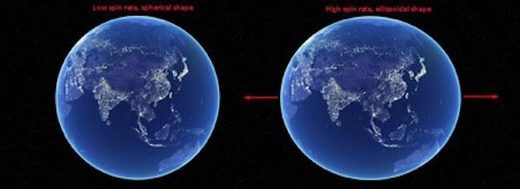
“Of course, the minute deformations of our planet caused by variations of solar activity induces tremendous mechanical stress on the Earth’s crust. The direct manifestations of this crust stress are earthquakes and eruptions.As described above, a link between comets and volcanic eruptions can be explained by the solar discharge that is caused by the passage of a comet as it moves past perihelion.“
These solar discharges induce a spike in positive charge in the Earth’s ionosphere, creating a minute acceleration of the Earth which can lead to the slippage of Earth’s crust, a major cause of volcanism and earthquakes.
Right around the time of the Great Comet of 1882, in November of that year, soon before the comet reached its maximum brightness, the Sun’s activity suddenly surged, with solar flares exceeding 500 intensity on November 18th, 20th and 21st (noticeable flares have an intensity greater than 3). These solar surges were the cause of the November 1882 magnetic storm, which had exceptional effects:
“…having an effect on telegraph systems, which were rendered useless in some cases. The Savannah Morning News reported that “the switchboard at the Chicago Western Union office was set on fire several times, and much damage to equipment was done. From Milwaukee, the ‘volunteer electric current’ was at one time strong enough to light up an electric lamp.” Measurements taken in the United Kingdom, where the telegraph also was affected, indicated that a telluric current five times stronger than normal was present…“
Thus, a series of three successive solar flares at the time of the passage of the Great Comet created a magnetic storm in November 1882, affecting the Earth’s ionosphere and generating a minute difference in rotation between the Earth’s crust and the mantle, making our planet more prone to earth changes and possibly causing – or at least contributing to – the seismic activity registered prior to the Krakatoa eruption which culminated in the explosive eruption on 27th August 1883.
As we enter a period of reduced sunspots and what an increasing number of scientists are calling a Grand Solar Minimum, we may soon – in the coming years – start witnessing an increase in major Earth Changes events.
In fact, one effect of solar minimums is to weaken the heliosphere surrounding the solar system and the magnetosphere surrounding the Earth. The heliosphere and the magnetosphere are the two “shields” that protect us from incoming bolides. Although Earth won’t be entirely without defense, the crater-laden surface of the Moon gives us an idea of the fate of astronomical bodies devoid of a magnetosphere. This article was first published by Matthias Forsingdal on SOTT. More on Strange Sounds and Steve Quayle.


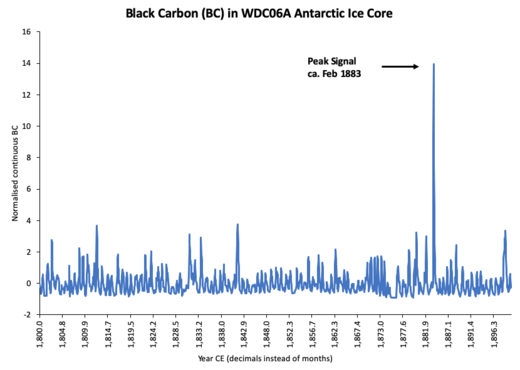
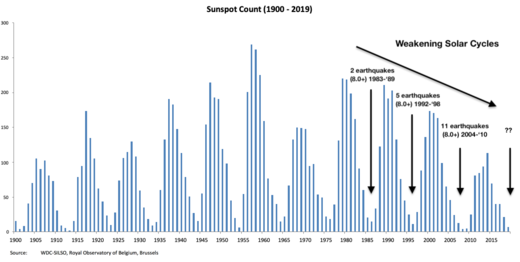











UNPRECEDENTED Comet C/2017 K2, still 10 months from perihelion, is inducing anomalous CMEs in the absence of sunspots which have been mistaken for a normal progression of Solar Cycle 25. The pandemic followed closely upon the heels of K2’s discovery. It doesn’t take a Sherlock Holms to crack this case. Hopi Prophecy is unfolding right before the heavily scaled eyes of a thoroughly misinformed humanity. Comets are cosmic antibodies…an immunological response to a terminally ill planet. The Corona Virus is the Cabal’s shot across the bow-shockwave of K2 which will induce Coronal Mass Ejections that will irradiate and eradicate the carcinoma afflicting this world.
During solar minimums when the sun’s heliosphere weakens more cosmic energy reachs Earth and the geologists say this cosmic energy excites silicious magma. Must be the piezoelectric effect mentioned in the article.
Great stuff! Now learn about the 535 ad Event. That worldwide event brought down empires, changed the climate forever, brought in the Little Ice Age, caused mass migrations, disease, starvation, the Plagues.